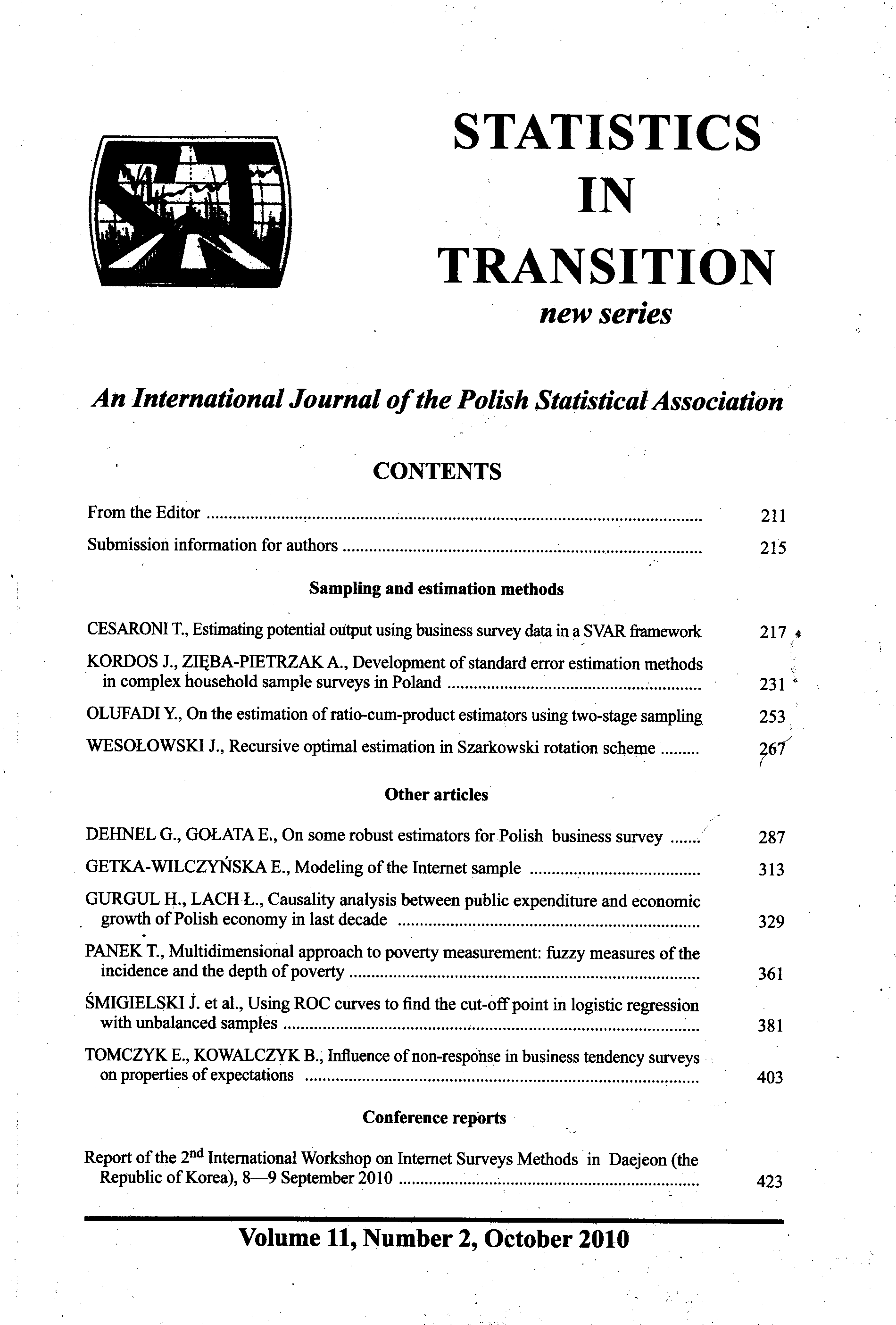ARTICLE
ABSTRACT
In this paper, we apply two-stage sampling which is not only commonly used in survey sampling but also has great advantages over element and cluster sampling. These advantages are comprehensively described in some sampling literature. Thus, we examine two-stage ratio-cum-product estimators with unequal subsampling fractions and obtain their MSE equations. The optimum sampling and sub-sampling fractions were also derived for these estimators. It is shown theoretically that these two-stage estimators will be more efficient than Singh (1965, 1967) estimators if certain conditions are satisfied. Finally, a numerical illustration with discussions is carried out to show the application of this technique.
KEYWORDS
auxiliary information, efficiency, mean square error, optimum sampling fraction, ratio-cum-product estimator, two-stage sampling.
REFERENCES
ABDUL, H. and JAVID, S. (2010): A family of ratio estimators for population mean in extreme ranked set sampling using two auxiliary variables. SORT 34 (1) January-June 2010, 45–64
ABU-DAYYEH, W.A., AHMED, M.S., AHMED, R.A., and MUTTLAK, H.A. (2003): Some estimators of a finite population mean using auxiliary information, Applied Mathematics and Computation 139: 287–298.
BANDYOPADHYAY, S. (1980): Improved ratio and product estimators. Sankhya Series C, 42(2), 45-49.
Cochran, W.G. (1963): Sampling techniques. John Wiley & Sons, New York.
DES, R. (1965): On a method of using multi-auxiliary information in sample surveys. J. Amer. Statist. Assoc. 60, 270–277
DIANA, G. and PERRI, P.F. (2007): Estimation of finite population mean using multi-auxiliary information. METRON - International Journal of Statistics, vol. LXV, n. 1, pp. 99–112.
HOSSAIN, M.I., and AHMED, M. S. (2001): A Class of Predictive Estimators in Two-Stage Sampling Using Auxiliary Information. Information and Management Sciences, Volume 12, Number 1, pp.49–55
KADILAR, C. and CINGI, H. (2004): Estimator of a population mean using two auxiliary variables in simple random sampling, International Mathematical Journal, 5, 357–367.
KADILAR, C. and CINGI, H. (2005): A new estimator using two auxiliary variables, Applied Mathematics and Computation, 162, 901–908.
KIREGYERA, B. (1980): A Chain Ratio-Type Estimator in Finite Population Double Sampling using two Auxiliary Variables. Metrika, 27: 217–223.
KIREGYERA, B. (1984): A Regression-Type Estimator using two Auxiliary Variables and Model of Double sampling from Finite Populations. Metrika, 31: 215–226.
MISHRA, G. and ROUT, K. (1997): A regression estimator in two-phase sampling in presence of two auxiliary variables, Metron 55(1–2), 177–186.
MUHAMMAD, H., NAQVI H., and MUHAMMAD, Q. S. (2010): Some New Regression Types Estimators in Two Phase Sampling. World Applied Sciences Journal 8 (7): 799–803.
MURTHY, M. N. (1964): Product method of estimation. Sankhya, A, 26, 69–74.
OLKIN, I. (1958): Multivariate ratio estimation for finite populations, Biometrika 45, 154–165.
PERRI, P. F. (2005): Combining two auxiliary variables in ratio-cum-product type estimators, Proceedings of Italian Statistical Society, Intermediate Meeting on Statistics and Environment, Messina, 21–23, 193–196.
RAO, P. S. R. S and MUDHOLKAR, G.S. (1967): Generalized multivariate estimator for the mean of finite populations, J. Amer. Statist. Assoc. 62, 1009–1012.
SAHOO, L.N. and PANDA, P. (1997): A class of estimators in two-stage samplings with varying probabilities. South African Statistics, J. 31, 151–160.
SAHOO, L.N. and PANDA, P. (1999): A class of estimators using auxiliary information in two-stage sampling. Australian and New Zealand Journal of Statistics, 41(4), 405–410
SAMIUDDIN, M. and HANIF, M. (2007): Estimation of population mean in single phase and two phase sampling with or with out additional information. Pak. J. Statist., 23 (2): 99–118.
SINGH, G.N. and UPADHYAYA, L.N (1995): A Class of Modified Chain-Type Estimators using Two Auxiliary Variables in Two-Phase Sampling. Metron, Vol. 53, N 3–4, 117–125.
SINGH, H.P. and ESPEJO, M.R. (2007): Double sampling ratio-product estimator of a finite population mean in sample surveys. J. Appl. Statist., 34: 71–85.
SINGH, H. P., SINGH, R., ESPEJO, M. R., PINEDA, M. D., and NADARAJAN, S. (2005): On the efficiency of the dual to ratio-cum-product estimator. Mathematical Proceedings of the Royal Irish Academy, 105A (2), 51–56.
SINGH, M. P. (1965): On the estimation of ratio and product of the population parameters. Sankhya, B, 27, 321–328.
SINGH, M. P. (1967a): Ratio cum product method of estimation, Metrika, 12, 34–42.
SINGH, M. P. (1967b): Multivariate product method of estimation for finite populations, Journal of the Indian Society of Agricultural Statistics, 31, 375– 378.
SINGH, R., CHAUHAN, P and SAWAN, N. (2007): A family of estimators for estimating population mean using known correlation coefficient in two phase sampling. Statistics in Transition, 8 (1): 89–96.
SRIVENKATARAMANA, T. (1980): A dual to ratio estimator in sample surveys. Biometrika, 67, 199–204.
SUKHATME, P.V., SUKHATME, B.V., SUKHATME, S. and ASHOK, C. (1984): Sampling theory of surveys with applications. Iowa State University Press, USA.
TAILOR R. and SHARMA, B. (2009): A Modified Ratio -Cum-Product Estimator of Finite Population Mean Using Known Coefficient of Variation and Coefficient of Kurtosis, Statistics in Transition- new series, vol. 10, pp. 15–24.
TRACY, D. S., SINGH, H. P., and SINGH, R. (1996): An alternative to the ratiocum- product estimator in sample surveys, Journal of Statistical Planning and Inference, 53, 375–387.
UPADHYAYA, L. N., and SINGH, H. P. (1999): Use of transformed auxiliary variable in estimating the finite population mean. Biometrical Journal, 41, 627–636.
UPADHYAYA, L.N. and SINGH, H.P. (2003): A Note on the Estimation of Mean Using Auxiliary Information. Statistics in Transition, Vol. 6, No. 4, 571–575.
WOLTER, K. M. (1985): Introduction to Variance Estimation, Springer-Verlag.
